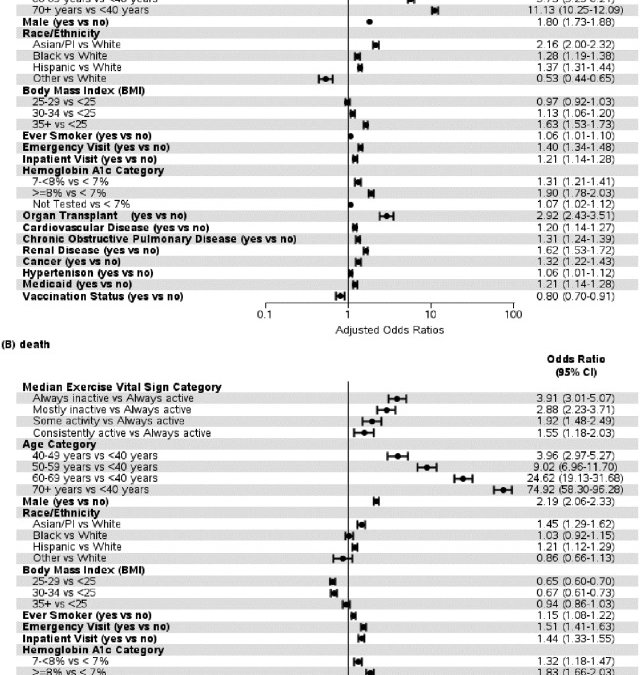December 21, 2022
In an article published on December 14, 2022 in MSN.com, researchers had been studying the effect of COVID-19 and exercise and had found a strong correlation or link between the disease and exercise according to research cited from an article published in the American Journal of Preventive Medicine. According to the retrospective research of over 194,000 adult COVID-19 patients diagnosed through Kaiser Permanente health records between January 2020 and May 2021 in Southern California, they found protective effects from physical activity for adverse COVID-19 outcomes across demographic and clinical characteristics.
In the study, the physical activity was assessed by a self-report scale called Exercise Vital Sign and was recorded in each patient’s EHR. In the main analyses, they used logistic regression to predict odds of hospitalization or death after a COVID-19 diagnosis, adjusted by age, sex, race, ethnicity, BMI, ever smoker, hospital utilization, HbA1c, comorbidities, Medicaid status, and vaccination status prior to COVID-19 diagnoses. They excluded patients with missing BMI but they did not discuss any other missing values for other covariates nor exclusion, deletion, or adjustment. They said to account for multiple comparisons that they used Bonferroni correction with n=21 to obtain an alpha of 0.00238 to compare again p-values of interaction terms. They also applied Bonferroni correction to the 95% confidence intervals.
To summarize their findings, they found there had been a higher prevalence of adverse COVID-19 outcomes across the lower physical activity categories and they even found that the patients who were always classified as inactive had the highest prevalence of hospitalization, deterioration event, or death. These patients had 91% higher odds of hospitalization (OR=1.91), 139% higher odds of deterioration event (OR=2.39) and 291% higher odds of death (OR=3.91) each in comparison to the patients in the always active category. They then stated that there was a dose-response effect present between amount of activity and odds of adverse COVID-19 outcomes as measured by hospitalization, death, or deterioration.
To summarize from this study, they concluded that there were protective associations of physical activity for adverse COVID-19 outcomes across demographic and clinical characteristics. They then advised that all public health leaders should add physical activity to pandemic control strategies. One thing this article did not address at all were those people who developed long-haul COVID-19 and then had trouble performing daily acitivites, especially exercise. No guidance or analysis is given per this population nor discussion about this, yet it is an important piece.
Written by,
Usha Govindarajulu
Keywords: COVID-19, physical activity, exercise, odds ratio, logistic regression, protective effects
References
Ryan, Maggie (December 14, 2022) “The Link Between Severe COVID and Exercise Is Even Stronger Than We Thought”. MSN.com. https://www.msn.com/en-us/health/fitness/the-link-between-severe-covid-and-exercise-is-even-stronger-than-we-thought/ar-AA15kLf2?ocid=entnewsntp&cvid=0282375bb5b8445db8b8bdcf4a8c8b9e#image=1
Young DR, Sallis JF, Baecker A, Cohen DA, Nau CL, Smith GN, and Sallie RE (2022). “Associations of Physical Inactivity and COVID-19 Outcomes Among Subgroups”.American Journal of Preventive Medicine, https://doi.org/10.1016/j.amepre.2022.10.007.
https://ars.els-cdn.com/content/image/1-s2.0-S0749379722005268-gr1.jpg
